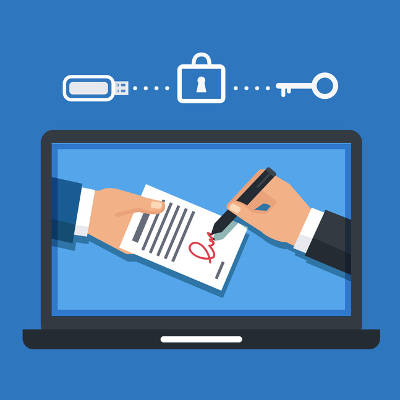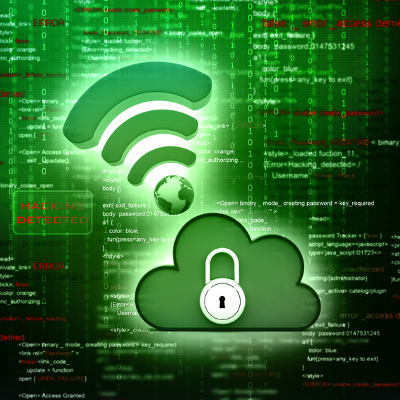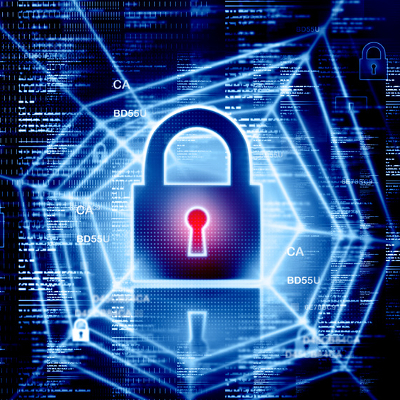Automation Helps Deliver Secure Networks and Infrastructure

If you do it manually, your business is spending countless hours on implementing patches and security updates. That’s not even mentioning the many other tasks that pile up if your technicians are simply too busy to get to them. Wouldn’t it be nice if these routine maintenances could be issued without the need for an on-site visit? Automation maintenance and management can certainly be worth the investment.
Automation Helps Deliver Secure Networks and Infrastructure

If you do it manually, your business is spending countless hours on implementing patches and security updates. That’s not even mentioning the many other tasks that pile up if your technicians are simply too busy to get to them. Wouldn’t it be nice if these routine maintenances could be issued without the need for an on-site visit? Automation maintenance and management can certainly be worth the investment.
Digital Signatures are More Efficient and Secure

Your signature has a lot of power, particularly in the business world. Because of this, it’s curious to see how so many companies are moving over to the more digital alternative. In order to fully take advantage of digital signatures for your organization, you need comprehensive security measures that can reinforce the authenticity of your signatures.
This movement to digital signature software is further augmented by electronic document storage. Hoping to reduce the amount of paper waste and printing costs, businesses have started to keep digital documents rather than physical file storage, which naturally makes digital signature software much more valuable as a whole. Going paperless allows organizations to ditch the bulky filing cabinets and allow for easy file searching.
Until digital signature took off, users would have to electronically “sign” documents by printing them out, signing them, and then either scanning them or mailing them to where they needed to go. Thanks to PDF editing software, it’s easier to move in the direction of digital signatures than ever before.
Understanding Digital Signatures
Official documents require a signature, which means that there will always be value for digital signing software. Digital signing solutions allow companies to sign documents even while working remotely, which creates more opportunity and provides more convenience as a whole. You can forget the original methodology of scanning, sending, printing, and so on. Forging signatures is much more tempting when getting the official signature is difficult, which can potentially help you dodge a worst-case scenario.
PDF software allows your organization to know for certain that a digital signature is more than just a scribble on a piece of paper. It has its roots in cryptography, which is a technology that is used by most secure transactions out there. It essentially works like this; a digital signature has digital keys attached to it that can confirm the identity of whoever signs it. Since digital signature uses encryption, it’s easier to know that your signatures are as authentic as possible.
Just like with a physical signature, you’ll see a graphical representation of the signature, a name of your choosing, and the location of where the document was signed. Furthermore, you’ll also receive a timestamp that shows when the signature was filed. Keep in mind that each solution is different, however. Not all PDF software solutions are the same. Investing in one is a great benefit, however, as you can move in the direction of flexibility for your organization.
For more information about digital signatures, reach out to Catalyst Technology Group at (317) 705-0333.
4 Resolutions to Keep Your Business Secure in 2018

With every new year comes great new opportunities, and 2018 is no different. However, change can be a good thing, and with a new year also comes more perspective and knowledge that you can use to make considerable improvements to the way you run your organization. Here are four ways that you can use developments in cybersecurity to help your business succeed in the new year.
Monitor Endpoint Security
One of the first things you need to check is how secure your endpoints are. By endpoints, we’re talking about any employee devices or workstations that access your business’ network. You need to ask yourself if your employees are using these endpoints as securely as possible. Do they have permissions that they need (or don’t need)? Do they misuse any permissions that they do have? These are all questions that will clue you in as to how secure your endpoints really are.
Your network security starts with your end users, and any risky situations that they find themselves in can reflect on your network. Your employees should understand how their actions can impact the way that your organization functions as a whole. In the same train of thought, your employees should understand the proper way to use devices, usernames, and passwords, so that hackers can take advantage of as few endpoints as possible. If you lose any employees, be sure to revoke their permissions so that you minimize the risk of unmonitored accounts becoming dangerous endpoints.
Apply Updates and Patches
One of the best ways to ensure network security is to keep your patches and security updates implemented as soon as possible. Cybercriminals and malware developers are always trying to overcome the security of software solutions commonly used by businesses and individuals. To counteract these malicious intentions, software developers are always fixing flaws that surface in a (hopefully) timely manner. Unless you implement these patches and security updates, you’re putting your business at risk.
Patching and updating your software solutions is the only way to make sure that your company is as secure as possible from threats. If you don’t take action now, you could very well be putting your company at risk of a data breach. You need to regularly patch your software solutions to make sure that hackers can’t take advantage of the latest bugs to infiltrate your organization.
Keep a Positive Attitude
Some of these resolutions might feel like you’re focusing too much on the negative, but there is always room to focus on the positive. Use your imagination a little bit and focus on what kinds of attacks you could potentially see against your business in the future. How would you protect from these attacks? You always want to make sure that you’re considering the best-case scenario.
To attain this standard, you want to take an honest look at what you’ll need to go one year without a cyber attack. You should then work toward this idealistic goal.
Cover Your Basics
Forgetting about simple security tactics can be the downfall of your business. Be sure to always follow password security requirements so that you can keep threats out of your network and accounts. Furthermore, you should implement two-factor authentication to make each hacker’s job even more difficult.
You should always be keeping your team in the loop, as well, ensuring that they know about any changes to procedure or new solutions implemented. Do you have any questions about how to optimize security in the new year? Let us know in the comments.
Which is More Secure, Your Mobile Network or Wi-Fi?

For the modern business, having a strategy to manage your employees smartphone use is essential. This is because most of the people that work for you have smartphones. One study shows that upwards of 90 percent of people under 30 own a smartphone. If you have any design on running a business, or employing millennials (who are the largest generation in the current workforce), you’ll need to know what you are doing to protect your business from the increasing amount of threats that are out there targeting smartphones.
An annual Wi-Fi Security Report conducted by Wandera found that, out of a sample of 100,000 corporate-owned mobile devices, 74% of wireless data was transferred using a Wi-Fi network, 12 percent of Wi-Fi hotspots used by those people are open and lacking encryption, and only four percent of these corporate-owned devices have been exposed to malware through an accidental or deliberate man-in-the-middle attack.
The man-in-the-middle attack (MiTM) is one where a computer will pick up malware that allows an intermediary to intercept files and correspondence between the two machines, and upon connecting to a network via a Wi-Fi connection, transfers the malware onto the computing network–thus infecting the network with the malware that allows the hacker to intercept any communication.
It’s largely understood that cellular networks are more secure than Wi-Fi networks, as cellular networks utilize high-end encryption techniques. This doesn’t make them popular, however. People will typically use Wi-Fi that is available. In fact, one statistic suggests that people are so addicted to the use of Wi-Fi that upwards of 60 percent of people will connect to any available public Wi-Fi rather than use the cellular data, even if they don’t pay for it themselves. Symantec’s Wi-Fi Risk Report corroborates this notion, adding that roughly the same number of people believe their personal information is more secure transmitted over Wi-Fi, and that 53 percent cannot tell the difference between a secure and unsecure Wi-Fi network. The report goes on to state that nearly nine out of ten consumers have put their information at risk by using public Wi-Fi.
At the business level things get a little better. While individual Wi-Fi use remains similar, businesses typically do a much better job of securing their network to keep malicious entities out. One way they do this is by setting up a firewall to keep their Wi-Fi networks away from the rest of their network. Typically, when a person accesses your organization’s Wi-Fi, they are then able to access your whole entire network. If your servers and other confidential data are linked to your organizational Wi-Fi, then an intruder who can manage to connect will then have access. By separating your Wi-Fi from your network behind a firewall, you will not only protect yourself from ambitiously malignant people on your network, but also go a long way toward safeguarding your network from cyber attacks in general.
Another way that the business can ensure their mobile strategy won’t hamstring their company’s network is by instituting a Virtual Private Network (VPN). The VPN brings additional encryption to data communication by creating a secure tunnel in which to transfer data. For the small business a VPN has become an almost essential part of providing your staff with a workable remote computing situation. Not only does it work to secure your business’ data while using available remote connections, it makes it easier to scale a business by allowing new systems to connect to it with minimal configuration. In doing so, the deployment of a strategic VPN reduces capital investment and is a major benefit for organizational mobility.
If you haven’t already, your business is going to have to address your mobile security before it gets burned. If you would like to learn more about what you are up against, or how you can utilize today’s security technology to protect your business’ important data, call Catalyst Technology Group today at (317) 705-0333.
Without These Tools, Your Network Isn’t Secure

Your business might have a limited budget, but this shouldn’t hold you back from implementing the best and strongest security solutions. However, security isa complicated process for any business. This is problematic, especially since common threats and vulnerabilities show up frequently in the business environment. We’ll walk you through some security basics so that you can optimize your organization’s protection.
First and foremost, the basic tasks of security tools can be accomplished through the use of preventative solutions found in a Unified Threat Management (UTM) device. A UTM includes a firewall, antivirus, spam blocker, and content filter, allowing you to reduce the number of threats your business is exposed to and prevent hacking attacks entirely.
Firewalls
Firewalls are generally considered the bouncers to your business’ network, as they keep track of the traffic that flows into and out of it. This keeps harmful threats from entering and causing trouble, and keeps dangerous traffic from spreading to other parts of your network. You can then isolate and destroy any threats that are identified as problematic. Most computers these days come with a consumer-grade firewall pre-installed, but you don’t want to rely on these for your business’ security. An enterprise-grade firewall found in a UTM can be just the thing you need to keep your network secure.
Antivirus
While your firewall is busy keeping threats out of your network, the antivirus will be the force responsible for quarantining and eliminating any that do slip past the defenses. Antivirus programs scan your computer for any abnormalities, and then take action to eliminate them.
Spam Protection
Spam is something that even the average PC user will encounter, as these messages in your inbox waste your time and threaten the security of potentially important information. If you don’t take a preventative stance against spam, it could bother your employees and trick them into clicking on the wrong links or attachments. Spam is the preferred method of travel for threats, as it’s easy to hide malicious code in embedded links or images, as well as attachments. With spam protection, you can keep these messages from getting to your inbox in the first place, saving you the time and effort required to comb through it for threats.
Content Filtering
If you have some employees who can’t seem to keep themselves off of social media or YouTube, how do you keep them on task? The best solution to this is a content filter, which allows your organization control over the website users’ access on the Internet. This also allows you to keep your employees from accessing sites that contain malicious, dangerous, or distracting content, allowing you to get more productivity out of your workers while maximizing security.
To take your business’s security to the next level, consider a UTM solution. To learn more, reach out to Catalyst Technology Group at (317) 705-0333.
Equifax Freeze PINs Aren’t As Secure As They Could Be

The Equifax data breach has been a considerable issue for countless individuals, exposing sensitive information that could lead to identity theft and so much more. In response to this breach, some experts are recommending that consumers go as far as freezing their credit lines because of the potential for breaches. Well, it all comes down to a PIN–something that can be easily guessed by a hacker under the right circumstances.
Personal identification numbers–contrary to popular belief–are the exact same thing as passwords. They are codes designed to keep someone from accessing sensitive information. However, access control devices like this need to follow the same guidelines, regardless of what they are called. They need to be complex and secure so as to keep hackers from guessing them. You should include both upper and lower-case letters, numbers, and symbols, and include them in a seemingly random order.
You’re probably thinking, “Great. Now I know enough to make my Equifax PIN as strong as possible.” Except… that’s not how this works.
Due to the way that Equifax generates your PIN, your credit lines could be placed at risk. The PINs used by Equifax are ten digits long, stemming from the date that the credit line was frozen, as well as the specific time which it was frozen. The order of these variables is the following: DdMmYyHhMm. This significantly cuts down on the amount of possible combinations available for a PIN. Furthermore, there are only a certain number of reasonable times within a day where you could apply for a credit line freeze, further limiting the amount of potential variables including the access code.
If Equifax had kept it a simple ten-digit randomized string of numbers, this wouldn’t be an issue. But that’s just not how the cookie crumbled.
As of September 11th, 2017, Equifax has addressed that this PIN generation process needs to be changed. Hopefully, the change will be enough to secure people’s sensitive information properly.
What are your thoughts about this development? Are you certain that your passwords and PINs are secure enough to protect your organization (and your identity) from being compromised? For assistance securing your personal and organizational information, reach out to Catalyst Technology Group at (317) 705-0333.

